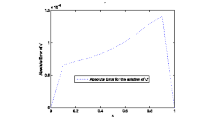Abstract
A geopotential model of the Earth is usually calculated using the Stokes coefficients. As computational power has increased, research is focusing more on new ways of gravity field modelling. The objective of this work is to study an application of the h-p finite element method for solving boundary value problems in physical geodesy. For the purpose of studying this method, we have formulated model boundary value problems with different boundary conditions. The algorithm for solving these test problems was designed and was subsequently implemented by the program. We derived a weak formulation for each model boundary value problem and also the corresponding finite element discretization. We used isoparametric reference elements with linear and quadratic shape functions. The authors present the application of the h and p methodologies for increasing the rate of convergence of our solution, discuss mesh generation for large domains, and also solve the model boundary value problem, which is similar to the geodetic boundary value problem.
Access this chapter
Tax calculation will be finalised at checkout
Purchases are for personal use only
Similar content being viewed by others
References
Babuška I, Dorr MR (1981) Error estimates for the combined h and p version of finite element method. Numer Math 37:252–277
Babuška I, Suri M (1990) The p- and h-p versions of the finite element method an overview. In: Canuto C, Quarteroni A (eds) Spectral and high order methods for partial differential equations. North-Holland, Amsterdam, pp 5–26
Babuška I, Szabo B (1982) On the rates of convergence of the finite element method. Int J Numer Methods Eng 18:323–341. doi:10.1002/nme.1620180302
Bathe K (1999) Finite element procedures. Prentice Hall, Prentice
Čunderlík R, Mikula K, Mojzeš M (2008) Numerical solution of the linearized fixed gravimetric boundary-value problem. J Geod 82(1):15–29
Ergatoudis J, Irons B, Zienkiewicz O (1968) Curved, isoparametric, quadrilateral elements for finite element analysis. Int J Solids Struct 4:31–42
Fašková Z, Čunderlík, Mikula K (2010) Finite element method for solving geodetic boundary value problems. J Geod 84(2):135–144
Grafarend E (1989) The geoid and the gravimetric boundary value problem, Report No 18. The Royal Institute of Technology (Dep of Geod), Stockholm
Grafarend E, Niemeier W (1971) The free nonlinear boundary value problem of physical geodesy. Bull Geod 101:243–261
Grafarend E, Heck B, Knickmeyer E (1985) The free versus fixed geodetic boundary value problem for different combinations of geodetic observables. Bull Geod 59(1):11–32
Hofmann-Wellenhof B, Moritz H (2005) Physical geodesy. Springer, New York
Holota P (2000) Direct methods in physical geodesy. In: Schwarz K-P (ed) Geodesy beyond 2000 - the challenges of the first decade. IAG general assembly, Birmingham, July 19–30, 1999, IAG symposia, vol 121. Springer, Berlin, pp 163–170
Holota P (2001) Variational methods in geoid determination and function bases. Phys Chem Earth Solid Earth Geod 24(1):3–14
Holota P (2005) Neumann’s boundary-value problem in studies on Earth gravity field: weak solution. In: Holota P, Slaboch V (eds) 50 years of Research Institute of Geodesy, Topography and Cartography, Prague, vol 50, No 36. Research Institute of Geodesy, Topography and Cartography, Prague, pp 49–69
Holota P, Nesvadba O (2007) Model refinements and numerical solutions of weakly formulated boundary-value problems in physical geodesy. In: Xu P, Liu J, Dermanis A (eds) VI Hotine-Marussi symposium of theoretical and computational geodesy, Wuhan, 29 May–2 June, 2006. IAG symposia, vol 132. Springer, Berlin, pp 314–320
Heck B (1989) On the non-linear geodetic boundary value problem for a fixed boundary surface. Bull Geod 63(1):57–67
Klees R (1995) Boundary value problems and approximation of integral equations by finite elements. Manuscr Geodaet 20:345–361
Klees R, van Gelderen M, Lage C, Schwab C (2001) Fast numerical solution of the linearized Molodensky problem. J Geodesy 75:349–362
Meissl P (1981) The use of finite elements in physical geodesy. Report 313, Geodetic Science and Surveying, The Ohio State University
Minarechová Z, Macák M, Čunderlík R, Mikula K (2015) High-resolution global gravity field modelling by the finite volume method. Stud Geophys Geod 59(1):1–20
Nesvadba O, Holota P, Klees R (2007) A direct method and its numerical interpretation in the determination of the Earth’s gravity field from terrestrial data. In: Tregoning P, Rizos C (eds) Dynamic planet. International association of geodesy symposia, vol 130. Springer, Heidelberg, pp 370–376
Rektorys K (1980) Variational methods in mathematics, science and engineering. D. Reidel Publishing Company, Dordrecht
Sansò F, Sideris M (2013) Geoid determination - theory and methods. Lecture notes in earth system sciences. Springer, Heidelberg
Shaofeng B, Dingbo C (1991) The finite element method for the geodetic boundary value problem. Manuscr Geod 16:353–359
Šprlák M, Fašková Z, Mikula K (2011) On the application of the coupled finite-infinite element method to the geodetic boundary value problem. Stud Geophys Geod 55:479–487
Acknowledgement
This work was supported by the Grant Agency of the Czech Technical University in Prague by grant No. SGS OHK1-016/15.
Author information
Authors and Affiliations
Corresponding author
Editor information
Editors and Affiliations
Rights and permissions
Copyright information
© 2016 Springer International Publishing Switzerland
About this paper
Cite this paper
Mráz, D., Bořík, M., Novotný, J. (2016). On the Convergence of the h-p Finite Element Method for Solving Boundary Value Problems in Physical Geodesy. In: Freymueller, J.T., Sánchez, L. (eds) International Symposium on Earth and Environmental Sciences for Future Generations. International Association of Geodesy Symposia, vol 147. Springer, Cham. https://doi.org/10.1007/1345_2016_237
Download citation
DOI: https://doi.org/10.1007/1345_2016_237
Publisher Name: Springer, Cham
Print ISBN: 978-3-319-69169-5
Online ISBN: 978-3-319-69170-1
eBook Packages: Earth and Environmental ScienceEarth and Environmental Science (R0)



